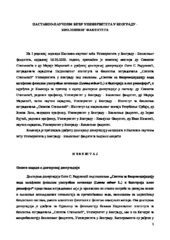Sistem za bioremedijaciju voda zagađenih fenolom upotrebom sočivice (Lemna minor L.) i bakterija njene rizosfere
System for bioremediation of phenol-polluted waters based on the application of the common duckweed (Lemna minor L.) and the bacteria of its rhizosphere
| dc.contributor.advisor | Stanković, Slaviša | |
| dc.contributor.other | Marković, Marija P. | |
| dc.contributor.other | Lozo, Jelena | |
| dc.contributor.other | Vujčić, Zoran | |
| dc.contributor.other | Nikolić, Ivan S. | |
| dc.creator | Radulović, Olga | |
| dc.date.accessioned | 2021-04-05T12:07:58Z | |
| dc.date.available | 2021-04-05T12:07:58Z | |
| dc.date.issued | 2020-12-28 | |
| dc.identifier.uri | http://eteze.bg.ac.rs/application/showtheses?thesesId=8026 | |
| dc.identifier.uri | https://fedorabg.bg.ac.rs/fedora/get/o:23450/bdef:Content/download | |
| dc.identifier.uri | http://vbs.rs/scripts/cobiss?command=DISPLAY&base=70036&RID=28971785 | |
| dc.identifier.uri | https://nardus.mpn.gov.rs/handle/123456789/18171 | |
| dc.description.abstract | U ovoj doktorskoj disertaciji ispitivano je uklanjanje fenola iz tečne hranljive podloge pomoću sočivice (Lemna minor L.) i bakterija njene rizosfere. Od ukupnog broja bakterijskih izolata rizosfere, izolovano je 6 sojeva kao najbolji kandidati za uklanjanje fenola: Lelliottia sp. 11, Klebsiella oxytoca 14, Serratia marcescens 27, Hafnia alvei 37, H. paralvei 43, i S. nematodiphila 51. Sočivice inokulisane bilo kojim od ovih sojeva efikasnije u uklanjanju fenol od površinski sterilisanih sočivica kao i od bilo kog od ovih sojeva u obliku slobodne suspenzije (bez sočivica). Soj H. paralvei 43, u kombinaciji sa sočivicom, bio je najefikasniji u uklanjanju fenola. Ovaj bakterijski soj utiče i na antioksidativni odgovor sočivice što se ogleda u povećanim enzimskim (GPX) i neenzimskim (ukupni solubilni proteini biljnog tkiva, MDA i H2O2) parametrima oksidativnog stresa.Zimogramskom detekcijom GPX utvrđeno je prisustvo pet različitih izoformi u tkivu sočivice gajenoj u prisustvu fenola, dok su četiri izoforme detektovane kada su na korenu bile prisutne bakterije bez fenola Fluorescentom mikroskopijom pokazano je da je K. oxytoca 14 endofit sa najizraženijim efektom na multiplikaciju sočivica sa ili bez fenola. Iz hranljive podloge bez fenola u kojoj su gajene sočivice i K. oxytoca 14 izolovano je 6 fenolnih jedinjenja: luteolin 6,8-di-C-heksozid, p-hidroksibenzoeva kiselina, kafeinska kiselina, apigenin 6-C-(2"-pentozil)heksozid i p-kumarinska kiselina. Rezultati ove doktorske disertacije pokazuju da su odabrani bakterijski sojevi u kombinaciji sa biljkama sočivice potencijalno rešenje za bioremedijaciju vode zagađene fenolom. | sr |
| dc.description.abstract | In this dissertation, the possibility of phenol removal by the common duckweed (Lemna minor L.) and by the bacteria of its rhizosphere, was investigated. Six bacterial strains, selected according to their ability of growth on the minimal nutrient medium with phenol, high phenol-resistance, sensitivity to typical antibiotics, biofilm formation, positive effect on the multiplication rates of the plants and bacteria-plant interactions on the root surface were: Lelliottia sp. 11, Klebsiella oxytoca 14, Serratia marcescens 27, Hafnia alvei 37, H. paralvei 43, and S. nematodiphila 51. Duckweed inoculated with any of the aforementioned strains were more efficient in phenol removal than the surface-sterilized duckweed or the bacterial suspensions. The most efficient bacterial strain/duckweed system is the one based on H. paralvei 43 and plants. This bacterial strain also modulates the antioxidant response of the plant, indicated by the non-enzymatic (total AsA, soluble proteins, MDA and H2O2) and the enzymatic parameters. The zymogram detection of GPX in the plants showed 5 phenol-induced GPX isoforms, whereas the bacteria alone induced 4 different GPX isoforms. Bacteria showed a tendency to lower the intensity of GPX expression in plants. K. oxytoca 14 is an endophyte which induced a rapid multiplication of the duckweed. Six phenolic compounds were identified in the nutrient medium used to co-culture K. oxytoca 14 and the duckweed: lutheolin 6,8-di-C-hexoside, p-hidroxybenzoic acid, caffeic acid, apigenin 6-C-(2"-pentosyl) hexoside and p-coumaric acid. The results of this dissertation show that the selected bacteria /duckweed systems present an efficient solution for the bioremediation of the phenol-polluted wastewaters. | en |
| dc.format | application/pdf | |
| dc.language | sr | |
| dc.publisher | Универзитет у Београду, Биолошки факултет | sr |
| dc.relation | info:eu-repo/grantAgreement/MESTD/Technological Development (TD or TR)/37001/RS// | |
| dc.relation | info:eu-repo/grantAgreement/MESTD/Basic Research (BR or ON)/173015/RS// | |
| dc.relation | info:eu-repo/grantAgreement/MESTD/Basic Research (BR or ON)/173026/RS// | |
| dc.rights | openAccess | en |
| dc.rights.uri | https://creativecommons.org/licenses/by/4.0/ | |
| dc.source | Универзитет у Београду | sr |
| dc.subject | bakterije | sr |
| dc.subject | bacteria | en |
| dc.subject | duckweed | en |
| dc.subject | bioremediation | en |
| dc.subject | phenol | en |
| dc.subject | sočivica | sr |
| dc.subject | bioremedijacija | sr |
| dc.subject | fenol | sr |
| dc.title | Sistem za bioremedijaciju voda zagađenih fenolom upotrebom sočivice (Lemna minor L.) i bakterija njene rizosfere | sr |
| dc.title.alternative | System for bioremediation of phenol-polluted waters based on the application of the common duckweed (Lemna minor L.) and the bacteria of its rhizosphere | en |
| dc.type | PhD thesis | |
| dc.rights.license | BY | |
| dcterms.abstract | Станковић, Славиша; Николић, Иван С.; Вујчић, Зоран; Марковић, Марија П.; Лозо, Јелена; Радуловић, Олга; Систем за биоремедијацију вода загађених фенолом употребом сочивице (Лемна минор Л.) и бактерија њене ризосфере; Систем за биоремедијацију вода загађених фенолом употребом сочивице (Лемна минор Л.) и бактерија њене ризосфере; | |
| dc.identifier.fulltext | https://nardus.mpn.gov.rs/bitstream/id/70554/IzvestajKomisije28545.pdf | |
| dc.identifier.fulltext | https://nardus.mpn.gov.rs/bitstream/id/70553/Disertacija.pdf | |
| dc.identifier.rcub | https://hdl.handle.net/21.15107/rcub_nardus_18171 |



